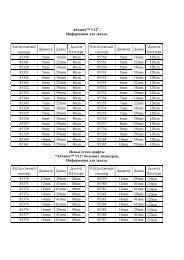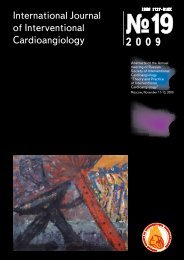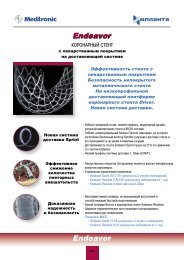Results of Coronary Stenting using the Stents with
Results of Coronary Stenting using the Stents with
Results of Coronary Stenting using the Stents with
Create successful ePaper yourself
Turn your PDF publications into a flip-book with our unique Google optimized e-Paper software.
Интервенционная Interventional angiology ангиология<br />
Successful Repair <strong>of</strong> a Giant Thoracic Aortic Aneurysm<br />
<strong>with</strong> De Bakey IIIB Dissection Using Hybrid Surgical<br />
Approach. A Clinical Case<br />
R.S. Akchurin 1 , S.V. Korolev, T.E. Imaev, A.E. Komlev, P.M. Lepilin, I.S. Fedotenkov, A.S. Kolegaev<br />
Department <strong>of</strong> Cardiovascular Surgery, Russian Cardiological Scientific and Production Complex <strong>of</strong> <strong>the</strong> Ministry<br />
<strong>of</strong> Healthcare and Social Development <strong>of</strong> <strong>the</strong> Russian Federation, Moscow, Russia<br />
Thoracic aortic aneurysms account for about 20% <strong>of</strong> all aortic aneurysms. Their incidence is 6 per 100000<br />
<strong>of</strong> patients per year (5). Aneurysm development is connected <strong>with</strong> media degeneration resulting from <strong>the</strong><br />
insufficiency <strong>of</strong> all layers <strong>of</strong> <strong>the</strong> aortic wall. The risk <strong>of</strong> rupture is related to <strong>the</strong> increase <strong>of</strong> aortic diameter (7).<br />
In 33-50% <strong>of</strong> cases <strong>the</strong> rupture leads to death (5,8).<br />
Aortic dissection is a complex emergency situation, occurring tw<strong>of</strong>old more frequently than abdominal aortic<br />
ruptures. The dissection <strong>of</strong> <strong>the</strong> aortic walls can cause dynamic or permanent obstruction, rupture or thrombosis<br />
<strong>of</strong> <strong>the</strong> aortic branches.<br />
Open surgical intervention is a traditional standard treatment for this condition. The mortality associated <strong>with</strong><br />
open interventions in <strong>the</strong> leading world centers is about 5-14% (for III type dissections) (10,11). The complications<br />
involve pulmonary, renal and cardiovascular systems and abdominal organs, thus significantly increasing<br />
<strong>the</strong> risk <strong>of</strong> death. Here<strong>with</strong> <strong>the</strong> rate <strong>of</strong> complications is directly related to <strong>the</strong> size and <strong>the</strong> extension <strong>of</strong><br />
<strong>the</strong> aneurysm. Concomitant diseases existing in many patients cause many problems related to open surgical<br />
interventions.<br />
With <strong>the</strong> account <strong>of</strong> open surgery-related risks, endovascular minimally invasive approach seems attractive<br />
and advantageous. The aim <strong>of</strong> endovascular aneurysm repair (EVAR) consists in <strong>the</strong> prevention <strong>of</strong> aneurysm<br />
rupture and aortic dissection by <strong>the</strong> way <strong>of</strong> aneurysmatic sac exclusion from <strong>the</strong> circulation, decreasing <strong>of</strong> <strong>the</strong><br />
tension <strong>of</strong> aneurysmatic sac’s walls or <strong>of</strong> <strong>the</strong> pressure in <strong>the</strong> false lumen <strong>with</strong> its subsequent closure.<br />
In order to illustrate <strong>the</strong> up-to-date possibilities <strong>of</strong> <strong>the</strong> aortic dissection repair we present a clinical case <strong>of</strong><br />
successful repair <strong>of</strong> a giant thoracic aortic aneurysm <strong>with</strong> De Bakey IIIB dissection and a parietal thrombosis<br />
<strong>using</strong> hybrid surgical method.<br />
Keywords: hybrid surgery, thoracic aortic aneurysms, aortic dissection, open surgery, endovascular interventions,<br />
endopros<strong>the</strong>sis, EVAR.<br />
Introduction<br />
According to expert data, thoracic aortic disease<br />
is diagnosed yearly in over 16,000 European patients<br />
(1,6). The development <strong>of</strong> aneurysms is related to<br />
media degeneration as a result <strong>of</strong> insufficiency <strong>of</strong> all<br />
aortic wall’s layers. Dissection occurs in about 50%<br />
<strong>of</strong> thoracic aortic aneurysms. In fact, <strong>the</strong>se are false<br />
aneurysms, as <strong>the</strong> process <strong>of</strong> dissection does not involve<br />
all aortic wall’s layers.<br />
The incidence <strong>of</strong> thoracic aortic aneurysms rupture<br />
is 3.5-5 / 100,000 patients per year. The risk <strong>of</strong><br />
rupture is related to <strong>the</strong> increase <strong>of</strong> aortic diameter<br />
(7). The rupture leads to death in 33-50% <strong>of</strong> cases<br />
(5, 8). Population studies have shown that 5-year survival<br />
in patients <strong>with</strong> untreated thoracic aneurysms <strong>of</strong><br />
various genesis is only 13% (5), while 3-year survival<br />
in patients <strong>with</strong> degenerative aneurysms is 35% (8,9).<br />
The dissection <strong>of</strong> thoracic aorta is a complex<br />
emergency situation occurring tw<strong>of</strong>old as <strong>of</strong>ten as<br />
1<br />
Address for correspondence:<br />
Dr. Renat Akchurin,<br />
Russia, 121552, Moscow,<br />
3rd Cherepkovskaya ul, 15а<br />
Tel. /Fax: 007 499 140-93-36, 007 499 149-17-08<br />
Email: dddd99999@mail.ru<br />
Manuscript received on June 06, 2011.<br />
Accepted for publication on August 22, 2011.<br />
abdominal aortic aneurysms. A<strong>the</strong>rosclerotic degeneration<br />
<strong>of</strong> <strong>the</strong> aortic wall in hereditary diseases, such<br />
as Marfan and Ehlers-Danlos syndromes, and arterial<br />
hypertension is a predictor for dissection. Local intimal<br />
rupture or intramural hematoma leads to abrupt<br />
blood inflow into <strong>the</strong> aortic media layers which ends<br />
by aortic dissection and <strong>the</strong> development <strong>of</strong> a false<br />
lumen. The dissection can extend proximally as well<br />
as distally to <strong>the</strong> site <strong>of</strong> initial lesion, thus creating<br />
aortic branches’ obstruction (dynamic or permanent),<br />
rupture or thrombosis.<br />
Aortic dissections can be classified by <strong>the</strong>ir location,<br />
duration and presence <strong>of</strong> ischemic complications.<br />
According to one <strong>of</strong> <strong>the</strong> most <strong>of</strong>ten used Stanford<br />
classification, type A includes <strong>the</strong> dissection <strong>of</strong><br />
<strong>the</strong> ascending aorta, type B — <strong>the</strong> dissection <strong>of</strong> <strong>the</strong><br />
descending aorta. De Bakey’s type I includes <strong>the</strong> dissection<br />
<strong>of</strong> <strong>the</strong> whole aorta, type II — <strong>the</strong> dissection<br />
<strong>of</strong> <strong>the</strong> ascending aorta, type III — <strong>the</strong> dissection <strong>of</strong><br />
<strong>the</strong> descending thoracic aorta and <strong>of</strong> <strong>the</strong> abdominal<br />
aorta.<br />
Pharmacological <strong>the</strong>rapy and regular diagnostic<br />
studies are indicated in most cases. Surgical interventions<br />
for asymptomatic aneurysms are recommended<br />
if aneurysmatic sac attains 5.5-6 cm in diameter,<br />
while acute symptomatic aneurysms irrespective <strong>of</strong><br />
34<br />
(№ 26, 2011)
















